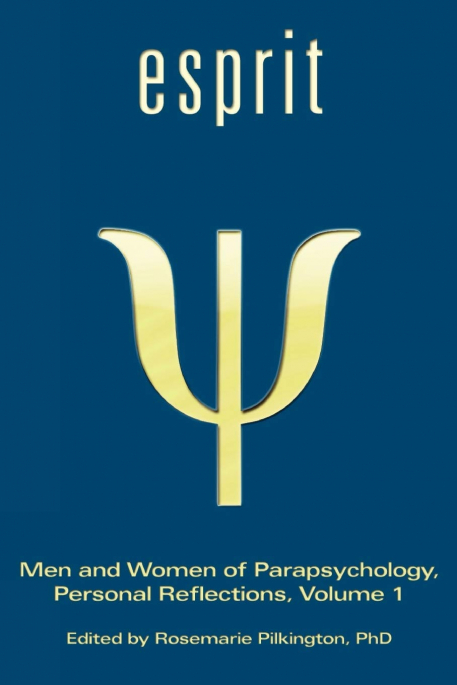
Publication Details
Anomalist Books. ISBN: 1933665505
Publish date
Reviewed by Tom Ruffles
Although it is possible to find occasional interviews and auto/biographical pieces, historians of psychical research and parapsychology have long needed the sort of series that psychologists enjoy with History of Psychology in Autobiography. The sole compilation of autobiographical sketches of eminent parapsychologists so far has been Rosemarie Pilkington’s 1987 Men and Women of Parapsychology. Long out of print, it has now been republished by Anomalist Books, with the addition of ‘ESPRIT’ as a prefix and ‘Volume 1’ as a suffix, heralding the arrival in due course of a further two volumes edited by Pilkington.
ESPRIT contains a dozen contributions from individuals who were over 65 in 1987 and who had made a significant contribution to the field. The twelve are Jule Eisenbud, Montague Ullman, Jan Ehrenwald, Eileen Coly, Joseph H. Rush, Gertrude R. Schmeidler, Emilio Servadio, Renée Haynes, Hans Bender, Karlis Osis, George Zorab and Bernard Grad. Of the twelve, only two – Eileen Coly and Bernard Grad – were still with us at the time of the 2010 reprint. We can all think of people whose recollections would be welcome, and it has to be a matter of regret when the opportunity to gather memories is lost. In fact, this is how the idea of such a book came about. Pilkington was at the 1983 Parapsychological Association conference, a time of major loss in the field – Arthur Koestler, J Gaither Pratt, Louisa Rhine (not long after the death of her husband J B Rhine), and Laura Dale, and she realised what had died with them.
That was the spur to collect “personal reflections by the ‘elder statespersons’ of the field” so that those who had not known them personally might still be able to benefit from their experience. To indicate how easy it is to be too late, Bender’s contribution is surprisingly short, but the reprint has a new editor’s note which explains that he had sent a draft and then suffered a stroke, so was unable to expand it. A couple who ‘got away’ were John Beloff, who characteristically, but entirely erroneously, felt that nobody would be interested in his career, and Ian Stevenson. It is a great shame that such eminent individuals did not contribute, but hopefully, with the example of Volume 1 before them, such refusals will be less likely in future.
To provide guidance, contributors were asked to consider five areas: how they became involved in the subject; what they thought were their most important contributions; what they might have done differently, or what beliefs had changed as a result of their experiences; what unusual experiences they might have had that exceeded their “boggle threshold”; and what advice they would give to young people entering the field. Pilkington interviewed Coly and Servadio, but all the others were given free range in what they supplied.
On balance I think I prefer the interview format because an essay can be edited and polished, and the writer occasionally bang on longer than strictly required about a topic, whereas an interviewer can guide the conversation and return to a subject that has not been answered satisfactorily, finding out things that might not make it into books and papers. A good example is the account by Servadio of how he took LSD and psilocybin with Eileen Garrett, which elicited more detail than a written response might have done, assuming it was mentioned at all. There is a partial bibliography for each author, plus a general bibliography at the end of the book, though these have not been updated past 1987.
Apart from a tendency to begin their interest at a fairly young age (which helps to explain why they are in the book, as they had been around long enough to have built up significant careers), and the sense that a number were very good friends, to be expected in a small field, there is not a huge amount that unites them. Occasionally an academic interest was stimulated by an extraordinary experience, as with Ullman, Osis, and Zorab, not forgetting Coly, who had the constant example of her mother, Eileen Garrett. A rough breakdown shows that only three could be classified as full-time in parapsychology (Coly, as an administrator, Bender, and Osis), four were psychiatrists (Eisenbud, Ullman, Ehrenwald, and Servadio), there was a single psychologist (Schmeidler), a physicist (Rush), a biologist (Grad), and two who were general psychical researchers/historians (Haynes and Zorab).
The only figure associated closely with the SPR in the dozen, and the only one I knew personally, was Renée Haynes, but I am told that volumes 2 and 3 will include more SPR figures. I particularly enjoyed Haynes’s piece with its rather patrician style, reminding me of the ‘noblesse oblige’ atmosphere that used to prevail in the SPR, one that has thankfully largely disappeared in these socially more relaxed times.
As Pilkington points out, the book has been cited many times since publication, showing the value of her idea (not least, it has to be said, to obituarists). The sort of initiative shown in this and its projected companion volumes should be formalised with an organised effort by one of the major organisations – the SPR, the Parapsychological Association or the Parapsychology Foundation – to collect accounts in a systematic way on a continuing basis, before memories are lost forever. The British Library has an extensive programme designed to gather oral history from a wide a range of individuals, acknowledging its importance to future researchers. Psychical research and parapsychology should be treated no differently.

